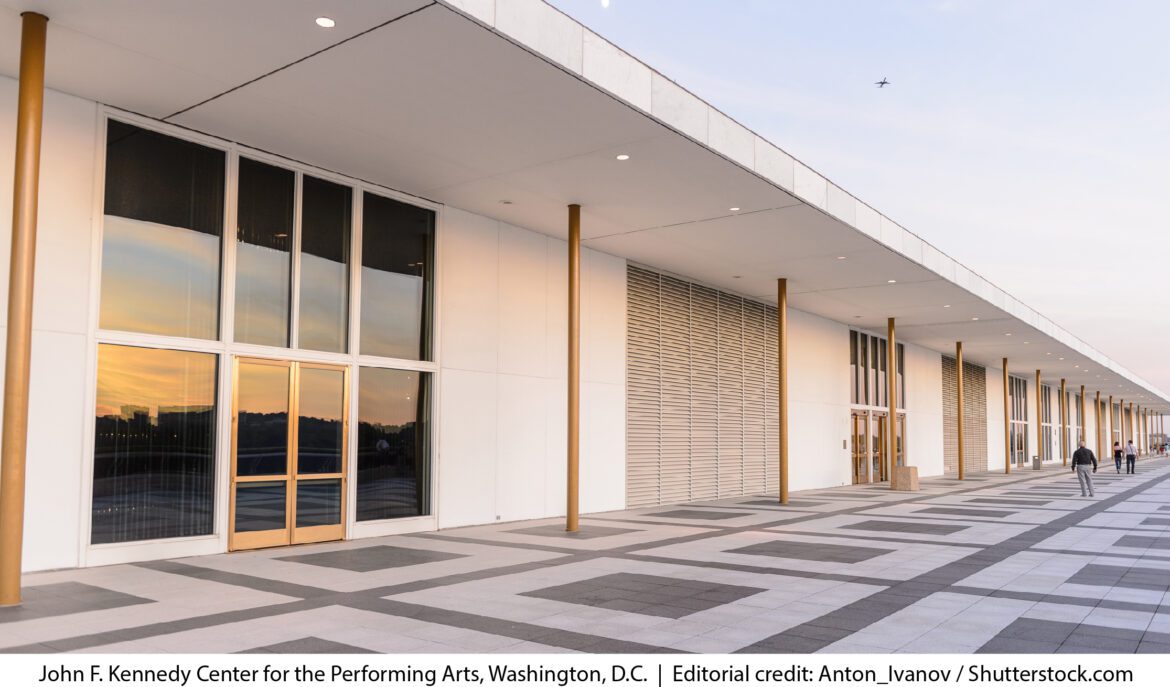The John F. Kennedy Center for the Performing Arts, commonly known as the Kennedy Center, is one of the busiest performing arts centers in the United States and a memorial to President John F. Kennedy. When it opened in 1971, the Kennedy Center became America’s National Cultural Center, dedicated to the performing arts and arts education.
Groundbreaking and Early Construction
In 1958, President Dwight D. Eisenhower signed bipartisan legislation to create a National Cultural Center near the National Mall in Washington, D.C. President Kennedy and his wife Jacqueline were early supporters of the project. Following Kennedy’s assassination in 1963, Congress designated the new Cultural Center as a “living memorial” to the late president, renaming it the John F. Kennedy Center for the Performing Arts.
The location on the Potomac River was previously a World War II temporary building occupied by the Department of Defense. Architect Edward Durell Stone designed the iconic Kennedy Center hall with its signature white tent-shaped roof. Ground broke in 1964 and construction took place over the next six years. President Lyndon B. Johnson officiated the groundbreaking in December 1964.
Grand Opening to the Public in 1971
The opening festival took place for two weeks in September 1971 with more than 50 of the world’s best orchestras, opera, dance and theater companies performing on multiple stages. Opera legend Leontyne Price sang arias at the Grand Foyer during intermission. The Kennedy Center officially opened on the night of September 8, 1971, with a gala performance featuring compositions by Leonard Bernstein. In attendance were ambassadors and Washington dignitaries along with President Richard Nixon, who remarked that Kennedy would have loved seeing artists from over 50 countries performing in the new Center.
Over the years, the Kennedy Center has hosted historic performances by legendary artists including Bob Dylan, Aretha Franklin, Mikhail Baryshnikov, Isaac Stern and many more. It presents shows daily on multiple stages, along with arts education programs, master classes, commissions and premieres of new works. The Center underwent renovations in the 1990s and a major expansion in the early 2000s.
State-of-the-Art Performing Arts Complex
Today, the Kennedy Center is an enormous facility, comprising over 1.5 million square feet. Major performance spaces include: the Opera House which seats 2,300, the Concert Hall at 2,500 seats, and the Eisenhower Theater that seats 1,100. Other venues are the Family Theater, Terrace Theater, Theater Lab, Millennium Stages and the Grand Foyer. The spectacular River and Rock Gardens with stunning D.C. views opened in 2013 after the Center’s expansion.
Every year, productions at the Kennedy Center enrich lives, culture and the creative spirit of over two million visitors. It has become the busiest performance venue in America with over 2,000 shows, performances and events annually across different genres including symphony, opera, theater, jazz and dance. The Kennedy Center Honors, Mark Twain Prize, comedy shows and free performances on the Millennium Stage further its mission of providing access for all to the finest in the performing arts.

